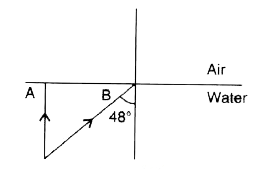A ray travelling from glass to air, bends away from the normal. ____
To solve the question, we need to understand the behavior of light as it travels from one medium to another, specifically from glass to air.
1. Identify the Media:
- The first medium is glass, which is a denser medium.
- The second medium is air, which is a rarer medium.
2. Understand Refraction:
- Refraction is the bending of light as it passes from one medium to another due to a change in speed.
- When light travels from a denser medium to a rarer medium, it bends away from the normal line.
3. Apply Snell's Law:
- Snell's Law states that n1 * sin(θ1) = n2 * sin(θ2), where n is the refractive index and θ is the angle of incidence or refraction.
- In this case, n1 (for glass) is greater than n2 (for air), which indicates that the angle of refraction (θ2) will be greater than the angle of incidence (θ1).
4. Conclusion:
- Since the light ray is moving from glass (denser) to air (rarer), it indeed bends away from the normal. Therefore, the statement "A ray travelling from glass to air bends away from the normal" is true.
Final Answer:
The statement is true.
---
- The first medium is glass, which is a denser medium.
- The second medium is air, which is a rarer medium.
- Refraction is the bending of light as it passes from one medium to another due to a change in speed.
- When light travels from a denser medium to a rarer medium, it bends away from the normal line.
- Snell's Law states that n1 * sin(θ1) = n2 * sin(θ2), where n is the refractive index and θ is the angle of incidence or refraction.
- In this case, n1 (for glass) is greater than n2 (for air), which indicates that the angle of refraction (θ2) will be greater than the angle of incidence (θ1).
- Since the light ray is moving from glass (denser) to air (rarer), it indeed bends away from the normal. Therefore, the statement "A ray travelling from glass to air bends away from the normal" is true.
The statement is true.
Topper's Solved these Questions
- LIGHT ENERGYBOOK - ICSECHAPTER - LIGHT ENERGYEXERCISE - EXERCISE-5.3 (Objective Type Questions) D. Tick the most appropriate answer.
5 Videos
- LIGHT ENERGYBOOK - ICSECHAPTER - LIGHT ENERGYEXERCISE - EXERCISE-5.3 (Objective Type Questions) E. Match the statements in column A, with those in Column B.
1 Videos
- LIGHT ENERGYBOOK - ICSECHAPTER - LIGHT ENERGYEXERCISE - EXERCISE-5.3 (Objective Type Questions) B. Statements given below are incorrect. Write the correct statements.
5 Videos
- HEAT TRANSFER BOOK - ICSECHAPTER - HEAT TRANSFER EXERCISE - Picture Study
2 Videos
- MATTER BOOK - ICSECHAPTER - MATTER EXERCISE - THEME ASSIGNMENT
25 Videos
Similar Questions
A ray of light travelling obliquely from glass to air :
View SolutionWhen a ray of light travels obliquely from a rarer medium to a denser medium, it bends away from the normal.
View Solution(a) State Snell's law of refraction of light.
(b) A transparent medium A floats on another transparent medium B. When a ray of light travels obliquely from A into B, the refracted ray bends away from from the normal. Which of these two media A or B are optically denser and why ?
View SolutionA : When a diver under water looks obliquely at a fisherman standing on the bank of a lake then fisherman looks taller.
R : When a ray of light travelling in air enters water, it bends towards the normal.
View SolutionIn the figure, you can see a light ray travelling from air to glass. Why is there no refraction?

View SolutionA converging set of ray, traveling from water to air, is incident on a plane interface. In the absence of the interface, the rays would have converged to a point O, 60 cm above the interface. However, dur to refraction the rays will bend. At what distance above the interface will the rays actually converge?

View SolutionIs the formula "Real depth/Apparent depth =μ. valid if viewed from a position quite away from the normal ?
View SolutionA ray of light travelling in air enters obliquely into water. Does the light ray bend towards the normal or away from the normal ? Why ?
View SolutionA light ray is travelling from air to glass. True reflected and refracted rays are perpendicular to each other. If the angle of incidence in air is I the refractive index of glass is
View SolutionFigure alongside shows two rays A and B travelling from water to air. If the critical angle for water-air surface is 48∘, complete the ray

diagram showing the refracted for each. State conditions when the ray will suffer total internal reflection.
View Solution
